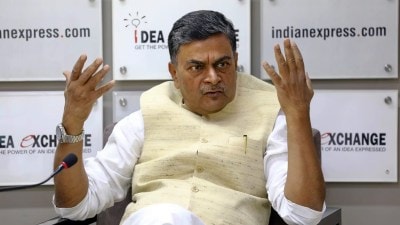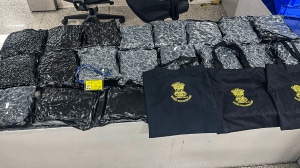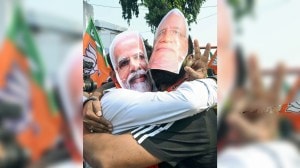Preserving the essence of Manipuri puppetry: A race against time
While the exact timing of Hanglai Jagoi's introduction is uncertain, it is believed to have originated during the time of Karta Maharaja (Bhagyachandra/Chingthangkhomba) and Maharaja Gambhir Singh (Chinglen Nongdrenkhomba).
 According to experts in this field, Hanglai Jagoi predates the introduction of Hinduism in Manipur. (Express Photos)
According to experts in this field, Hanglai Jagoi predates the introduction of Hinduism in Manipur. (Express Photos)Written by Moirangthem Nganbarel Meetei
From the early period in Manipur, ‘Hanglai Jagoi’ (puppetry dance) was performed in every locality and street, mainly enjoyed by children. However, this art form is gradually becoming extinct due to numerous challenges. Manipur also boasts other famous art forms such as Lai Haraoba, Khunung Eshei, Nat Sangkhritan, Raas Leela, etc. Moreover, Nat Sangkritan was recognised as an Intangible Heritage of Humanity by UNESCO in 2013, and Raas Leela was recognised as a classical dance of India.
According to experts in this field, Hanglai Jagoi predates the introduction of Hinduism in Manipur. While the exact timing of its introduction is uncertain, it is believed to have originated during the time of Karta Maharaja (Bhagyachandra/Chingthangkhomba) and Maharaja Gambhir Singh (Chinglen Nongdrenkhomba). They performed it during Raas Leela and Ratha Yatra. Due to increasing demand, it was also incorporated into Goura Leela.
To preserve this valuable art form, Gurumayum Bashantakumar Sharma established a cultural organisation called Mopet Decoration and Cultural Centre in Thiyam Leishangthem, Imphal West district, in 1994. In an exclusive conversation with Moirangthem Nganbarel Meetei, Sharma mentioned that his cultural organisation also showcases many folktales through this art form. Having learned Hanglai Jagoi from his father at the age of 14, Sharma recognised the threat of extinction and started researching this art form under various gurus.
 The race against time to protect Manipuri puppetry, dance, and music is a challenge that demands immediate attention from authorities, cultural enthusiasts, and the community at large. (Express Photo)
The race against time to protect Manipuri puppetry, dance, and music is a challenge that demands immediate attention from authorities, cultural enthusiasts, and the community at large. (Express Photo)
Sharma explained that Hanglai Jagoi is of four types: Rod Puppet, Shadow Puppet, Glove Puppet, and String Puppet. Technological advancements and a decline in community participation are contributing factors to the ‘extinction’ of this art form. During his father’s time, they performed this art form more than 20 times a year, but now it is only showcased during festivals or specific programs, Sharma added.
Sharma observed that in the vibrant and culturally rich landscape of Manipur, where tradition is interwoven with the fabric of daily life, there exists an urgent call for action to preserve the age-old art forms of Manipuri puppetry, dance, and music. Despite the best efforts of revered gurus and ojahs (teachers), these traditional performing arts are facing the ominous threat of disappearance, he added.
The real threat lies in the dwindling number of gurus and ojahs in this field. As these custodians of tradition pass away, the vital aspects of Manipuri puppetry theatre, which are already few in number, face the risk of disappearing altogether.
The race against time to protect Manipuri puppetry, dance, and music is a challenge that demands immediate attention from authorities, cultural enthusiasts, and the community at large. The disappearance of these traditional art forms, Sharma remarked, would not only be a loss for Manipur but also a blow to the broader Indian cultural tapestry. As the curtain threatens to fall on this unique heritage, the responsibility lies with the authorities to take meaningful action, ensuring that Manipuri puppetry, dance, and music endure for generations to come, he concluded.
The author is an intern with the Indian Express



- 01
- 02
- 03
- 04
- 05




























